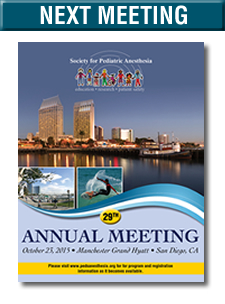spa meeting reviews
AAP Session
By Cheryl K. Gooden, MD
Mount Sinai Medical Center
New York, NY
2015 AAP Robert M. Smith Award Presentation
The Robert M. Smith Award is presented annually at the SPA/AAP Pediatric Anesthesiology Meeting in recognition of the amazing contributions of an individual to the subspecialty of pediatric anesthesiology. As some background, the first award was presented in 1986 by the AAP Section on Anesthesiology and Pain Medicine to honor Dr. Smith for his numerous contributions to both the fields of pediatrics and pediatric anesthesiology. Each year, a list of nominees is solicited from among our peers in pediatric anesthesiology for review by the Nominations Committee.
Charles H. Lockhart, MD is the 2015 recipient of the American Academy of Pediatrics Robert M. Smith Award, which was presented by Randall M. Clark, MD. Dr Lockhart’s many contributions to the field of pediatric anesthesiology were highlighted during the award ceremony. Among his many contributions, he is credited with bringing pediatric anesthesiology to the forefront at The Children’s Hospital in Denver. For many years, Dr. Lockhart has been an active participant on various committees for SPA, ASA, as well as Chair of the AAP Section on Anesthesiology. This is a well deserved honor, and Dr. Lockhart is to be congratulated as the latest recipient of this prestigious award.
2015 AAP Advocacy Lecture
Gerald B. Hickson, MD (Vanderbilt University Medical Center) delivered the 2015 AAP Advocacy Lecture, titled “The Patient Advocacy Reporting System (PARS) and Behaviors that Undermine a Culture of Safety”. He began by presenting an overview of Vanderbilt University’s pediatric advocacy reporting system (PARS) and behaviors that do not align with principles of patient safety. The first objective of this presentation was to examine the relationships between behaviors that undermine a culture of safety and suboptimal outcomes. The second objective was to recognize behaviors that undermine a culture of safety and define a “professional accountability pyramid”. The final objective was to describe an organizational infrastructure that relates to these behaviors.
Dr. Hickson highlighted the term “reliability,” and how it relates to PARS. First, he explained that the system must be a “failure free operation over time, effective, efficient, timely, patient-centered, and equitable.” Second, the system has to include a vision, goals and core values. Finally, a willingness to report and address must prevail.
Dr. Hickson explored “professionalism,” and the ways in which we are most accountable. Teamwork and self and group regulation are essential aspects of professionalism. In addition, as professionals we must engage in clear and effective communication, modeling respect, and self-awareness.
He examined the use of surgical safety checklists at several institutions. Of note, the overall impact of checklists to improve surgical outcomes was not compelling. That being said, the following question was then presented to the audience as to whether or not the “surgical safety checklists are worth our time and effort?”
The final portion of Dr. Hickson’s presentation focused on behaviors that undermine a culture of safety. He gave several examples that included actions that interfere with ability to achieve intended outcomes, a negative impact on policies and safety. Ultimately, for the system to be effective we must commit to professional behavior.



